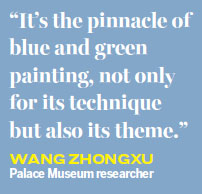Rare glimpse of a masterpiece

A Panorama of Rivers and Mountains, the only surviving work from painter Wang Ximeng of the Song Dynasty is being shown at Beijing's Palace Museum
An 18-year-old genius left the world with a work that has resonated for nine centuries. Indisputably, A Panorama of Rivers and Mountains, the only surviving work from painter Wang Ximeng of the Song Dynasty (960-1279) is one of the most important in China's fine art history.
The work, together with 85 others, is being exhibited in Beijing as part of A Panorama of Rivers and Mountains: Blue-green Landscape Paintings from Across Chinese History, which opened at the Palace Museum, also known as the Forbidden City, on Sept 15.
| Part of A Panorama of Rivers and Mountains, the lone surviving painting by Song Dynasty artist Wang Ximeng, is among dozens of works being showcased at the grand exhibition A Panorama of Rivers and Mountains: Blue-green Landscape Paintings from across Chinese History at the Palace Museum in Beijing. Provided to China Daily |
"The blue and green paintings have relatively thick mineral pigments and are thus difficult to preserve," says Palace Museum researcher Wang Zhongxu, curator of the exhibition. "It is extremely rare to see a 900-year-old painting intact."
He says the 11-meter-long scroll painting is a record of people's lives and the natural scenery of that time, mixing realism with creative imagination. There are mountains, rivers, villages, ports, temples and pavilions.
"We can also see all kinds of human activities," he says. "For example, some people are sightseeing, some are in caravans and others are living as hermits."
He describes the details as a grand aura.
"Song Dynasty paintings are renowned for their delicate details," he says. "And this work is an outstanding representative. It's the pinnacle of blue and green painting, not only for its technique but also its theme."
For the opening ceremony of the Beijing Olympic Games in 2008, a huge digital version of this painting was projected onto the center of the stadium.
The painter, Wang Ximeng, who was born in 1096, was part of the imperial painting academy of the Song Dynasty. He was tutored by Emperor Huizong, a fine art guru, and handed in this painting at the age of 18.
As for his other achievements, the details are vague. But it is known that he died in his 20s.
The painting was acquired by the Forbidden City during the reign of Qianlong (1735-96).

The two times the work has been dispayed before - in 2009 and 2013 - it was not fully unrolled because of space constraints. This time, a special exhibition case has been made to display it in full, along with critics' comments.
Referring to the comments, Wang says: "A monk from the Yuan Dynasty (1271-1368) said that he had seen the painting hundreds of times but found something new each time he viewed it."
According to Wang, blue and green paintings were a very important genre in Chinese landscape painting in the Tang (618-907) and Song dynasties. But their status was lost to ink-and-wash works after literati paintings, which emphasize more subtle and plain emotions, rose in prominence in the Yuan Dynasty (1271-1368).
"The change led people to nurture a stereotype that Chinese paintings are ink and wash," Wang says. "But traditional Chinese paintings were also abundant in color."
The exhibition is a bid to promote blue and green paintings and revive the lost position of the genre, Wang says. "This will help people understand Chinese landscape painting."
The exhibition has five sections, including the origin of blue and green painting in the fourth century, its peak in the Song Dynasty, later developments and, finally, its absorption of Western techniques.
Among the displayed works is Springtime Jaunt by Zhan Ziqian during the Sui Dynasty (581-618) - believed to be the oldest surviving blue and green painting.
Rivers and Mountains in Autumn, another top painting from the Song era, known for its depiction of peaks, is also among the exhibits.
Shan Jixiang, the museum director, says: "The exhibition is the outcome of research in our museum. We'd like to narrow down our topics and set specific themes. So the exhibitions reflect our achievements in academic studies."
Earlier, key paintings in the Palace Museum used to be exhibited in rotation two to three times a year, but there was no specific theme. This old display method was abandoned in 2015.
Now, top paintings in the Palace Museum like A Panorama of Rivers and Mountains are stored for three to four years before being exhibited at least once.
"If people want to see it again, they have to wait," Shan says.
In 2015, when Alongside the River During the Qingming Festival, one of the best-known Chinese paintings, also from the Song Dynasty, was exhibited in the Palace Museum, visitors stood in long lines to see it.
"Long lines are also expected this time," Shan says.
Nevertheless, as a separate exhibition space is set aside for A Panorama of Rivers and Mountains and six other works, the director says things will be better this time.
"Still, we will consider setting a quota for visitors," he says. "But the specific number will depend on the response."
wangkaihao@chinadaily.com.cn
| Staff members from the Palace Museum arrange the Song Dynasty masterpiece for the exhibition. Photos by Zhang Wei / China Daily |
(China Daily Africa Weekly 09/22/2017 page19)
Today's Top News
- Ukraine crisis a lesson for the West
- Autonomous networks driving the progress of telecom sector
- China launches cargo drone able to haul up to 1.2 tons
- Key role of Sino-German ties stressed
- Tariffs hurt global trade: Experts
- Rescuers race against time to find survivors
































